If you were expecting some kind of sun sign nonsense, forget about it. This is real astrology for the real world. If it's real astrology for yourself that you want, you can get it by phone or in print. And if you need help deciphering the astrological glyphs in the graphics accompanying this article, see Astroglyphs: Astrological Symbols Guide. Please note: this forecast is expressed in terms of Universal Time (UT). Also please be aware that, while I never change a forecast once it's published, I do post errata to acknowledge typographical errors and the like.
I have made all the calculations; fate will do the rest.
-- Napoleon
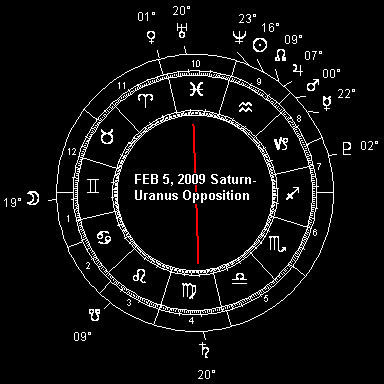 Last year’s annual forecast nailed the headlines of 2008: the global economic crisis and the election of Barack Obama chief among them. "The big story for 2008," I wrote, "is money . . . and the money, in a word, is gone." It remains the big story for 2009, which will come as no surprise to anyone who read my 2008 forecast in full. We’re still in the early phase of a process of economic transformation that won’t be completed until the next Jupiter-Saturn conjunction, in 2020. Along the way, and particularly over the next couple of years, the global financial system remains in dire straits. As for President Obama, before the first primary caucus or election, my 2008 forecast described him as "clearly a man of destiny," named him as one of the two likeliest Democratic Presidential nominees – no, the other one wasn’t the then-front runner, Senator Clinton - and forecast that "a Democrat, most likely" would win the election. (Remember, that forecast was published in late 2007, back when Sen. Obama was generally regarded as a long shot and his timed birth data hadn’t been released.) Now that the money’s gone and the long shot has indeed won the election – per last year’s forecast – the obvious question is: where is this taking us? What’s next?
Last year’s annual forecast nailed the headlines of 2008: the global economic crisis and the election of Barack Obama chief among them. "The big story for 2008," I wrote, "is money . . . and the money, in a word, is gone." It remains the big story for 2009, which will come as no surprise to anyone who read my 2008 forecast in full. We’re still in the early phase of a process of economic transformation that won’t be completed until the next Jupiter-Saturn conjunction, in 2020. Along the way, and particularly over the next couple of years, the global financial system remains in dire straits. As for President Obama, before the first primary caucus or election, my 2008 forecast described him as "clearly a man of destiny," named him as one of the two likeliest Democratic Presidential nominees – no, the other one wasn’t the then-front runner, Senator Clinton - and forecast that "a Democrat, most likely" would win the election. (Remember, that forecast was published in late 2007, back when Sen. Obama was generally regarded as a long shot and his timed birth data hadn’t been released.) Now that the money’s gone and the long shot has indeed won the election – per last year’s forecast – the obvious question is: where is this taking us? What’s next?
People are asking whether the world economy is in a recession or a depression. The answer, frankly, is yes. The term depression was originally used to describe an economic slump because the previously used nomenclature, panic, was considered too, well, panicky. Take the Panic of 1873, for example, which coincided with a quintuple Saturn-Uranus opposition like the one dominating the 2008-2010 celestial scene. (It’s an alignment that appeared once in the fall of 2008, makes two appearances in 2009, and two more in 2010.) Fearful that calling the 1929 crash a panic would cause a panic, the Hoover administration readily accepted the milder sounding term depression. (It was the British economist Lionel Robbins who coined the term "The Great Depression" in 1934.) After that one turned into one of America’s (and the world’s) worst nightmares, subsequent administrations determined that economic downturns should be called something else – anything else – to avoid triggering a national malaise. They settled on recession, which seemed to carry a less threatening connotation – until the current one came along, at any rate. Chances are, the Orwellian types will coin a new term to replace recession, by the time this one is done. A rose is a rose is a rose . . . and some are more equal than others.
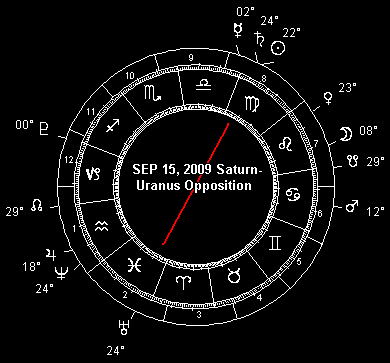 The Saturn-Uranus opposition of November 4, 2008 (the US Presidential Election Day) was the first in the current series of alignments between these two planets, continuing with two in 2009 and two more in 2010. (The signature Saturn-Uranus opposition of this year – of the whole 2008-2010 series of five, arguably - is the September 15 event, in which Earth and Uranus are aligned on one side of the solar system, while Saturn on the other side is aligned with the Sun.) The 2008-2010 quintuple alignment of Saturn and Uranus is in turn part of a complex of planetary patterns with deep, broad roots into the past and future. It’s the signature of a historic watershed, the ongoing and historic shift in civilization I've been writing about in my forecasts these past several years. It hit critical mass, as I have written, under the aegis of the 2006 Saturn-Jupiter-Neptune T-square configuration (the first of its kind since the year 536), and the subsequent 2006-2007 Saturn-Neptune opposition. (A T-Square is comprised of three planets, two of which are opposite each other as seen from Earth, with a third planet at ninety degrees to each of the other two.) These in turn are rooted in what the astrologers of old called the Trigonalis, the historic watershed we've all been living in since 1980-81 and which culminates in 2020. The Saturn-Uranus opposition of 2008-2010 is one of the major signposts along the way. This year’s Jupiter-Neptune triple conjunction is a new addition to the ménage, a further development in the process.
The Saturn-Uranus opposition of November 4, 2008 (the US Presidential Election Day) was the first in the current series of alignments between these two planets, continuing with two in 2009 and two more in 2010. (The signature Saturn-Uranus opposition of this year – of the whole 2008-2010 series of five, arguably - is the September 15 event, in which Earth and Uranus are aligned on one side of the solar system, while Saturn on the other side is aligned with the Sun.) The 2008-2010 quintuple alignment of Saturn and Uranus is in turn part of a complex of planetary patterns with deep, broad roots into the past and future. It’s the signature of a historic watershed, the ongoing and historic shift in civilization I've been writing about in my forecasts these past several years. It hit critical mass, as I have written, under the aegis of the 2006 Saturn-Jupiter-Neptune T-square configuration (the first of its kind since the year 536), and the subsequent 2006-2007 Saturn-Neptune opposition. (A T-Square is comprised of three planets, two of which are opposite each other as seen from Earth, with a third planet at ninety degrees to each of the other two.) These in turn are rooted in what the astrologers of old called the Trigonalis, the historic watershed we've all been living in since 1980-81 and which culminates in 2020. The Saturn-Uranus opposition of 2008-2010 is one of the major signposts along the way. This year’s Jupiter-Neptune triple conjunction is a new addition to the ménage, a further development in the process.
That’s not all. There’s also the Pluto transition from Sagittarius to Capricorn. It’s been underway since January 26, 2008, and was accomplished on November 28, 2008. The year 2009, like 1763, is the first full year of an extended Pluto in Capricorn sojourn. The previous continuous transit lasted from 1762 to 1777; although there were a couple retrograde forays back into Capricorn before the uninterrupted transit through the next sign (Aquarius) got underway in 1778. The sidereal period of Pluto (the time it takes to complete an entire orbit) being a little over 247 years, there have been a great many Pluto transits through Capricorn down through the centuries . . . including one from 532 to 551, during the crucial period I have referred to many times in my recent annual forecasts, because of it being the epoch of the Jupiter-Saturn-Neptune T-Square of 536.
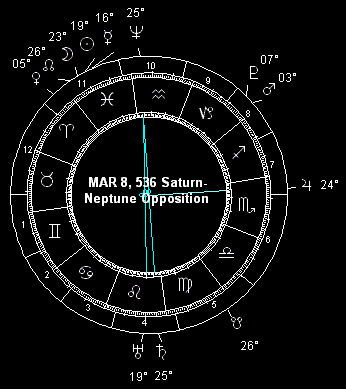 The 536 T-Square from Saturn in Leo to Jupiter in Scorpio to Neptune in Aquarius was the first configuration of these planets in that particular sign combination since 3734 BCE. That prehistoric event came near the end of the Neolithic Subpluvial climate epoch, aka the Holocene Wet Phase, and it marked a period of sudden and severe climate change. It brought the end to a warm and rainy period in North African climate history that lasted from about 7000 to 3300 BCE. (Some authorities extend it to 3000 BCE.) The effects were global, although different in different regions: a sudden freeze in the Peruvian Andes, the onset of desertification in the Sahara, a drought in England and Ireland, floods in Mesopotamia. The point is, long term climate change accompanied this rare T-Square.
The 536 T-Square from Saturn in Leo to Jupiter in Scorpio to Neptune in Aquarius was the first configuration of these planets in that particular sign combination since 3734 BCE. That prehistoric event came near the end of the Neolithic Subpluvial climate epoch, aka the Holocene Wet Phase, and it marked a period of sudden and severe climate change. It brought the end to a warm and rainy period in North African climate history that lasted from about 7000 to 3300 BCE. (Some authorities extend it to 3000 BCE.) The effects were global, although different in different regions: a sudden freeze in the Peruvian Andes, the onset of desertification in the Sahara, a drought in England and Ireland, floods in Mesopotamia. The point is, long term climate change accompanied this rare T-Square.
Climate change was also part of the picture drawn up around the time of the 536 T-Square: volcanic winter, with unusually low temperatures and snow in the summer; floods in arid regions; crop failures and stunted tree growth (the latter documented by tree ring studies). Volcanologist Ken Wohletz has reviewed the geological evidence and concludes that the Dark Ages and indeed a whole historic shift in global human civilization were triggered by a volcanic eruption (where Krakatoa is now) in 535, which initiated a cycle of global cooling on the order of "5 to 10 degrees C or more lasting over 10 to 20 years," (followed by) "subsequent global warming with remaining water vapor acting as a greenhouse gas and decreased ozone." (See "Were the Dark Ages Triggered by Volcano?" by Ken Wohletz, Los Alamos National Laboratory.)
It's just as clear that another time of climate shift is underway in this, the era of the 2006 T-Square. Like Al Gore, I’m no climatologist. Unlike him, I won’t presume to delineate the causes of today’s climate change, let alone prescribe what needs to be done about it. Maybe nothing needs to be done about it. Maybe it’s a natural cycle that just happens to turn up every couple thousand years or so – like the Saturn-Jupiter-Neptune T-Square in Leo, Scorpio and Aquarius. Astrologers often make the mistake of proclaiming that planetary cycles cause all kinds of things – including climate change; much as lay climatologists simplistically jump to the conclusion that human industrial activity causes today’s climate change. Given that climate change is now happening on Mars, which is notably lacking in industry; or that climate change accompanied the great T-Square in 3734 BCE and 536 CE (periods in terrestrial history lacking in industry) . . . who really knows what constellation of factors is at work here? The only consistent factor I see, as an astrologer looking at history, is the Great T-Square sequence. Describing the Great T-Square sequence as the cause of climate change is certainly simplistic. Denying that they happen together would be foolish.
There’s more than climate change involved in the Great T-Square sequence. The key concept here focuses on the idea of sequence. Saturn-Jupiter-Neptune T-Squares in Leo-Scorpio-Aquarius are a fairly rare celestial configuration that can only happen some five or six years after a Jupiter-Saturn conjunction in Taurus that occurs when Neptune is in Aquarius, or late in the preceding sign (Capricorn); and a few years before a Jupiter-Saturn opposition from Pisces to Virgo. If this sounds a little complicated, it’s because it is indeed a complex relationship between giant outer planets forming a defined pattern in a definite sequence as seen from Earth. It’s easy to focus on the configuration itself – the planets, arcs and signs involved – and lose sight of the crux of the matter: this is a sequence, something which can only happen in a defined pattern, order and chronology.
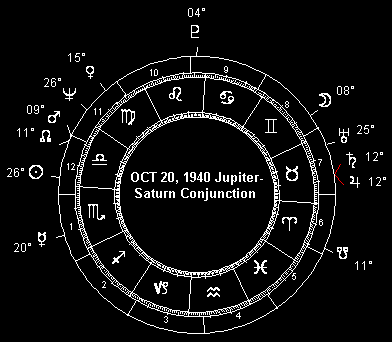 Jupiter-Saturn squares happen on a ten-year cycle, and their conjunctions are 20 years apart. Saturn-Neptune oppositions are fewer and farther between, happening on a 35-year cycle. But Saturn-Neptune oppositions from Leo to Aquarius are a lot rarer than that. The 2006-2007 alignment of these two planets was the first in Leo-Aquarius since 1683, and before that 1181-1182; there won’t be another until 2329-2330. Likewise, Jupiter-Saturn conjunctions in the zodiacal earth signs (Taurus, Virgo and Capricorn) happen in a sequence that comes around only about once every 800-900 years or so. To come up with a combination of a Jupiter-Saturn conjunction in Taurus closely followed by a Saturn-Neptune opposition in Leo-Aquarius can take a thousand years or more.
Jupiter-Saturn squares happen on a ten-year cycle, and their conjunctions are 20 years apart. Saturn-Neptune oppositions are fewer and farther between, happening on a 35-year cycle. But Saturn-Neptune oppositions from Leo to Aquarius are a lot rarer than that. The 2006-2007 alignment of these two planets was the first in Leo-Aquarius since 1683, and before that 1181-1182; there won’t be another until 2329-2330. Likewise, Jupiter-Saturn conjunctions in the zodiacal earth signs (Taurus, Virgo and Capricorn) happen in a sequence that comes around only about once every 800-900 years or so. To come up with a combination of a Jupiter-Saturn conjunction in Taurus closely followed by a Saturn-Neptune opposition in Leo-Aquarius can take a thousand years or more.
But put them all together in a defined, simultaneous pattern of Jupiter in Scorpio squaring Saturn in Leo and Neptune in Aquarius – the T-Square – and what you’ve got is a configuration that makes its appearance in the heavens only once every couple thousand years on average. It all kicks off with a Jupiter-Saturn conjunction in Taurus, the last of which took place back in 2000 and set the stage for the 2006 T-Square sequence, emphasizing fundamental structural change in the world financial system - a system which, as presently constituted, dates back to the last triple conjunction of Jupiter and Saturn in Taurus in the 1940s; which, incidentally, was the first such triple conjunction since the one in 562-561 BCE. Interesting coincidence: the current world financial system dates back to the establishment of the US dollar as the global reserve currency back in the 1940s, while history records the first use of gold coinage as an innovation by King Croesus, ruler of Lydia from 560 to 546 BCE. This curious parallel led me to suggest several years ago that buying gold and silver bullion coins whenever there's a price dip might just make a person, as the saying goes, "rich as Croesus." (I’m still getting thank-you notes and emails s from clients who took that late 2005 suggestion to heart.)
Incidentally, there won’t be another Jupiter-Saturn triple conjunction in Taurus until 2794-2795. And you have to go back to 4594-4593 BCE to find one before the 562-561 BCE triplet. These things are rare. The fact that two out of the three to have occurred in the last 6500 years have been world-historic social, cultural and economic watersheds is curious indeed. As for the one that doesn’t qualify in this respect, it may be simply for lack of data. After all, 4594-4593 BCE was prehistoric and therefore by definition lacking in proper documentary evidence one way or the other. It is generally recognized in archaeology as something of a crucial transitional phase of human development: the end of the Neolithic Period, the shift from the Stone Age into ancient history – the latter ending, by most accounts, in the 6th Century CE (which included the previous Saturn-Jupiter-Neptune T-Square in Leo-Scorpio-Aquarius).
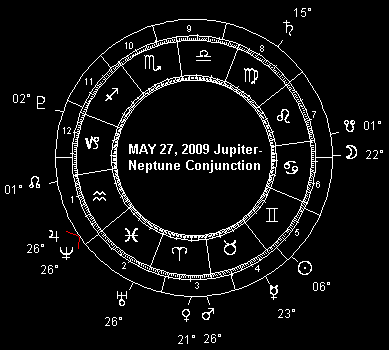 Fundamental changes in civilization do not occur without fundamental changes in economic activity and organization. Marxists and capitalists may argue whether one causes the other. Regardless, they do arise together in time. Two of the most radical and fundamental such transitions came in the wake of the 4594-4593 BCE Jupiter-Saturn triple conjunction in Taurus (the transition from prehistory to the ancient world, marked by the widespread harnessing of horses, sheep, cattle and the like as force multipliers for human endeavor); and in the wake of the 562-561 BCE triplet (the introduction of the first modern money in Lydia.) A third was the global marketplace created under the auspices of the Bretton Woods Agreement in the wake of the 1940s triplet, which gave us the International Monetary Fund (IMF), the World Bank, and the US dollar as the world’s international reserve currency.
Fundamental changes in civilization do not occur without fundamental changes in economic activity and organization. Marxists and capitalists may argue whether one causes the other. Regardless, they do arise together in time. Two of the most radical and fundamental such transitions came in the wake of the 4594-4593 BCE Jupiter-Saturn triple conjunction in Taurus (the transition from prehistory to the ancient world, marked by the widespread harnessing of horses, sheep, cattle and the like as force multipliers for human endeavor); and in the wake of the 562-561 BCE triplet (the introduction of the first modern money in Lydia.) A third was the global marketplace created under the auspices of the Bretton Woods Agreement in the wake of the 1940s triplet, which gave us the International Monetary Fund (IMF), the World Bank, and the US dollar as the world’s international reserve currency.
Given that the Great T-Square sequence is rooted in a preceding Jupiter-Saturn conjunction in Taurus (though not necessarily a triplet), it’s not surprising that these too are coincident with world-historic transitional phases in human civilization. The 536 T-Square from Saturn in Leo to Jupiter in Scorpio to Neptune in Aquarius was the first configuration of these planets in that particular sign combination and sequence since 3734 BCE. It marked the beginning of the so-called Dark Ages in Europe – the Early Middle Ages, more properly.
I bring up all these historic transitions and their corresponding cosmic configurations to emphasize the momentous nature of our times. This isn’t an ordinary epoch, this isn’t business as usual. The rare combination and sequencing of the patterns forming in the sky over the past sixty years or so, and for the next dozen years to come, has few precedents in all of history. And those it does have suggest very strongly that the economic collapse and climate change we’re experiencing now are not just ordinary ups and downs.
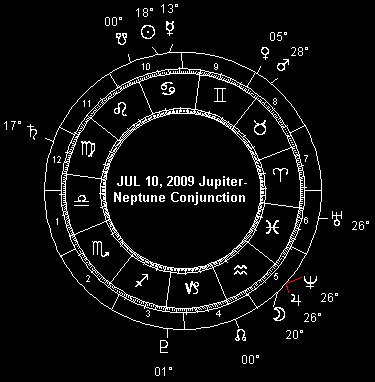 Consider the Saturn-Uranus opposition, the dominant celestial theme of 2009, the next step in the unfolding of the Great T-Square sequence that began with the 2000 Jupiter-Saturn conjunction in Taurus, moved on to the Jupiter-Saturn square of 2005-2006 and the Saturn-Neptune opposition of 2006-2007. This is the same sequence of planetary alignments associated with the Great T-Squares of 3734 BCE and 536 CE. Next up in the chain: the 2008-2010 quintuple Saturn-Uranus opposition (repeated twice in 2009) and the Jupiter-Neptune triple alignment of 2009.
Consider the Saturn-Uranus opposition, the dominant celestial theme of 2009, the next step in the unfolding of the Great T-Square sequence that began with the 2000 Jupiter-Saturn conjunction in Taurus, moved on to the Jupiter-Saturn square of 2005-2006 and the Saturn-Neptune opposition of 2006-2007. This is the same sequence of planetary alignments associated with the Great T-Squares of 3734 BCE and 536 CE. Next up in the chain: the 2008-2010 quintuple Saturn-Uranus opposition (repeated twice in 2009) and the Jupiter-Neptune triple alignment of 2009.
Saturn oppositions to Uranus come at intervals of about forty years, and generally occur as a series of several alignments. The last set of Saturn-Uranus oppositions, for example, occurred in 1965-1967, and included five alignments in all. Two of these occurred with Saturn retrograde, and three with Uranus retrograde, all in the Virgo-Pisces polarity. The US Mint stopped producing silver coins around the time of this particular set of oppositions, and the US Treasury stopped redeeming Silver Certificates as well. Reality went out of monetary circulation because the US dollar had been sufficiently devalued that the silver in a silver dollar was worth more than a dollar.
That's what Saturn-Uranus oppositions do: they replace a bankrupt regime with a new one, because the old fiction becomes too expensive to maintain. Social and cultural stability tend to decay as stresses stemming from the conflict between reality and convention increase. King Charles I of England was beheaded on January 30, 1649 – just a few weeks after the fourth in a series of five Saturn-Uranus oppositions from Gemini to Sagittarius that ran from 1647 to 1649, during the English Civil War (1642-1651). The quintuple Saturn-Uranus opposition of 1782-1783 started out from Sagittarius to Gemini, and then merged into a Capricorn-Cancer alignment. It came during a period of financial crisis in France, when the country was nearing bankruptcy after running up huge budget deficits for years - one of the chief causes that led to the French Revolution and the collapse of the monarchy.
The 2008-2010 opposition is exact five times, from November 4, 2008 to July 26, 2010. Once again, this set includes two alignments with Saturn retrograde and Uranus direct, and three with Saturn direct and Uranus retrograde. The first four alignments are in the Virgo-Pisces polarity, like every other Saturn-Uranus opposition since August 13, 1919. And then things change: the July 26, 2010 alignment slides into the Aries-Libra polarity, where it will remain well into the next century. It's the first sign change for this opposition since the 1918-1920 set, which began in Leo-Aquarius in 1918 and slid into Virgo-Pisces in 1919. Saturn-Uranus oppositions won't change signs again until 2146.
As I pointed out in last year’s forecast, the first polarity change in the Saturn-Uranus opposition since 1919 coming into play in the current sequence of oppositions between these two planets suggests to me that the World-War I era - the League of Nations (and its successor, the United Nations), the IRS, the Federal Reserve Bank - is finally coming to an end. So is the era of the Industrial Revolution, which historians date to the late 18th and early 19th Centuries - coinciding with the beginning of the current earth sign series of Jupiter-Saturn conjunctions.
Under the aegis of the remaining four Saturn-Uranus oppositions, this year and next will be among the most challenging in the transition between the old, bankrupt global financial system and its successor. This entails what can euphemistically be called a tremendous social dislocation: people losing their work, their houses, their savings, their security; people even in what were once considered wealthy nations facing hunger and deprivation. Not everyone, mind you. Even in the Great Depression of the 1930s, the US unemployment rate didn’t exceed 25%, meaning that most people still had jobs. It’s the kind of socio-economic storm that set up the English Civil War, the French Revolution, the Bolshevik Revolution and the cultural revolutions around the world in the late 1960s – all of which occurred under the aegis of Saturn-Uranus oppositions.
We’re early into the process, which begins with massive deflation and climbing unemployment in the wake of the latest bubble to burst. There may yet be one more bubble left, the last gasp of the dying order: the green bubble, which will attempt to redress the double-digit unemployment rate that awaits many of the G-20 nations (including the US) in 2009-2010. But in any event it’s only temporary. They have all been only temporary: the tech bubble and the real estate bubble have been just the two most recent. The fact is that the whole world has been a bubble land for nearly 40 years now, since the Bretton Woods protocol collapsed in 1971. A fiat currency system floats on a cushion of bubbles. When the last bubble pops, the whole thing sinks. This is the settling of the soufflé I’ve been talking about these past several years: one bubble pops, and the system just flattens out a bit; it settles a bit more each time the next bubble pops. Eventually, it hits bottom when there’s nothing left to inflate the next bubble.
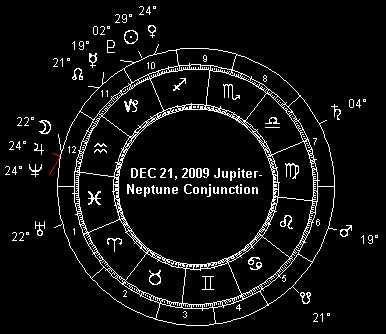 That ‘one last bubble’ seems to be heralded by the Jupiter-Neptune triple conjunction of 2009, the first such "three-peat" alignment of these two planets since 1971, when the US went off the gold standard. It was on August 15 that year – a little more than four weeks before the last of the triple conjunctions of Jupiter and Neptune in 1971 – when President Nixon announced that the United States would no longer redeem its currency for gold. Jupiter and Neptune were then within three degrees of their final conjunction in the threefold Sagittarius sequence. (Saturn was opposite Neptune and Jupiter was opposite Saturn simultaneously that summer.)
That ‘one last bubble’ seems to be heralded by the Jupiter-Neptune triple conjunction of 2009, the first such "three-peat" alignment of these two planets since 1971, when the US went off the gold standard. It was on August 15 that year – a little more than four weeks before the last of the triple conjunctions of Jupiter and Neptune in 1971 – when President Nixon announced that the United States would no longer redeem its currency for gold. Jupiter and Neptune were then within three degrees of their final conjunction in the threefold Sagittarius sequence. (Saturn was opposite Neptune and Jupiter was opposite Saturn simultaneously that summer.)
Conjunctions of Jupiter and Neptune occur on a roughly 13-year cycle. Usually there’s only one alignment; but in some years, when these two planets turn retrograde shortly after they align in our sky, the alignment is repeated twice more – one retrograde and one direct, for a total of three in the series. Such a triple alignment occurred only twice in the 20th Century: 1919-1920 (in Leo) and the aforementioned 1971 triplet in Sagittarius. The 21st Century features three triples: 2009 (in Aquarius), 2047-2048 (Taurus), and 2085-2086 (Leo). The 2009 triplet in Aquarius is the only one in this sign this century. There will be two Aquarius alignments in the next century; one in 2163, followed by a second in 2176. There won’t be another after that until 2329.
Jupiter-Neptune conjunctions in a given sign come in cycles of 150 years, more or less; not counting the retrograde triplets, and allowing for a sequence of one conjunction early in a sign followed by another late in the same sign a dozen or so years later. Accordingly the 2009 alignment in Aquarius is rare enough in its own right. Add in the "three-peat" element, and you’ve got a rare bird indeed. The last triple conjunction in Aquarius took place in 1843, and the one before that was in 1191. You have to go all the way back to 459 BCE to find more than an ordinary garden variety single-pass Jupiter-Neptune conjunction in Aquarius. In that year there was a triple alignment, with the first two occurring in Aquarius and the third in the last degree of the preceding sign, Capricorn.
A blind faith in the power of humanity is part and parcel of the Jupiter-Neptune conjunction. In the post World War I alignment, this manifested in the League of Nations and the creation of a massive global economic bubble that culminated in the 1929 Crash and subsequent Great Depression. The 1971 alignment brought the dematerialization of the US dollar, poisoning the lifeblood of the global financial system: ending the gold standard for the international reserve currency put the whole planet on a fiat monetary system, which by definition amounts to a Ponzi scheme (otherwise known as a pyramid scheme). The Bernard Madoff case put pyramid schemes under a spotlight for the first time in years, but Madoff is a rank amateur compared to the central bankers of the world.
In this connection, there’s a sobering irony in the pyramid on the reverse side of the US dollar bill: this currency used to be real, and now it’s a pyramid scheme. That wouldn’t matter much to the grand scheme of things if the dollar were merely the currency of a single nation, even a rich one like the United States. But it’s the international reserve currency, the major asset held in central banks around the world. National currencies have collapsed many times throughout history. Never before has there been a collapse of what amounts to a global currency. That’s what follows the Jupiter-Neptune triple conjunction of 2009, as the US prints more and more fiat currency in an attempt to spend its way out of recession. It works for a time, because demand destruction caused by hard times around the world will keep inflation under control at first. (This year’s Venus intersolar cycle heralds a brief bounce anyway.) But as the dollar is debased through government-directed capital spending and free-basing monetary policy, inflation begins to raise its head once more, wringing the last bit of savings out of the system. (Look at the interest you’re getting and tell me it isn’t true!)
There will be a solution, and it amounts to putting the global financial system on a new footing. But it develops over a period of years, with a key point in the process coming under the auspices of the 2010-2011 triple opposition from Jupiter to Saturn. International conferences moving in that direction will happen in 2009, in the spring and summer and again at the end of the year. A real gold standard again? Probably not. The house doesn’t want its hands tied, preferring to gin up chips at its convenience. But a de facto gold standard will develop as paper currencies depreciate relative to precious metals, and relative to other paper currencies issued by nations and central banks with substantial gold reserves.
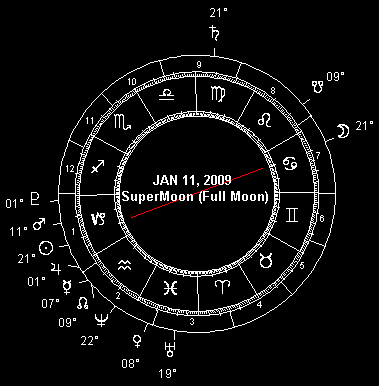 SuperMoon is a word I coined in a 1979 article for Dell Publishing Company's HOROSCOPE magazine, describing what is technically termed a perigee-syzygy; i.e. a new or full moon (syzygy) which occurs with the Moon at or near (within 90% of) its closest approach to Earth (perigee) in a given orbit. In short, Earth, Moon and Sun are all in a line, with Moon in its nearest approach to Earth. (My most recent print article on this subject appeared in the October-November 2007 issue of The Mountain Astrologer.)
SuperMoon is a word I coined in a 1979 article for Dell Publishing Company's HOROSCOPE magazine, describing what is technically termed a perigee-syzygy; i.e. a new or full moon (syzygy) which occurs with the Moon at or near (within 90% of) its closest approach to Earth (perigee) in a given orbit. In short, Earth, Moon and Sun are all in a line, with Moon in its nearest approach to Earth. (My most recent print article on this subject appeared in the October-November 2007 issue of The Mountain Astrologer.)
Like eclipses, there are typically four or five SuperMoons annually. We get five this year. These include the full moon on January 11 at 21° 02’ Cancer, followed by a trio of new moons in the summer: one on June 22 (1° 30' Cancer), followed by the July 22 total solar eclipse at 29° 27 Cancer, and a third on August 20 at 27° 32’ Leo. Last comes the partial lunar eclipse on December 31 at 10° 15’ Cancer. Notice the focus in Cancer, where all but one of this year’s SuperMoons take place. This does not bode well for crops in the fields this summer. Weather extremes seem poised to hurt yields, and consequently raise prices on foodstuffs at a time when most other prices are tending lower. Added incentive to stock the pantry with non-perishables if you can . . .
SuperMoons are noteworthy for their close association with extreme tidal forces working in what astrologers of old used to call the sublunary world: the atmosphere, crust and oceans of our home planet - including ourselves, of course. From extreme coastal tides to severe storms to powerful earthquakes and volcanic eruptions, the entire natural world surges and spasms under the sway of the SuperMoon alignment - within three days either way of the exact syzygy, as a general rule. SuperMoon solar eclipses tend to have a wider sphere of impact, extending roughly a week before and after the actual event. And other lunar extremes (of declination, for example) can extend the geocosmic stress window by a day or two here and there in any case.
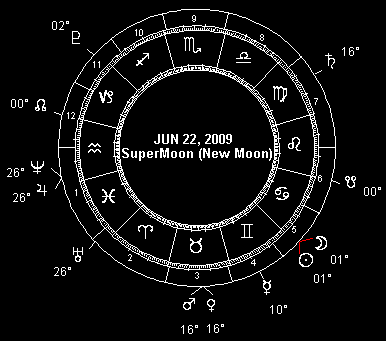 If you're interested in the history of SuperMoon alignments in connection with great storms, earthquakes and volcanic eruptions, you'll find a sampling of them in my book Interpreting Astrology (published by American Federation of Astrologers). But a simple review of the news over the past few years should serve to get you acquainted. Take Hurricane Katrina, for example; spawned from a tropical depression formed within three days of the August 19 SuperMoon. My forecast for 2005 warned of severe storms within plus or minus three days of the day Hurricane Katrina formed, and even specified the Gulf of Mexico as one of the areas at risk in connection with that particular SuperMoon alignment. I've done this for some thirty years now, from articles in the astrology press to the online forecasts at my website, Astropro.
If you're interested in the history of SuperMoon alignments in connection with great storms, earthquakes and volcanic eruptions, you'll find a sampling of them in my book Interpreting Astrology (published by American Federation of Astrologers). But a simple review of the news over the past few years should serve to get you acquainted. Take Hurricane Katrina, for example; spawned from a tropical depression formed within three days of the August 19 SuperMoon. My forecast for 2005 warned of severe storms within plus or minus three days of the day Hurricane Katrina formed, and even specified the Gulf of Mexico as one of the areas at risk in connection with that particular SuperMoon alignment. I've done this for some thirty years now, from articles in the astrology press to the online forecasts at my website, Astropro.
Examples of the SuperMoon connection with major storms and seismic events abound: the Mt. Pinatubo eruption, the largest volcanic event in the second half of the 20th Century, took place on June 15, 1991 (within three days of a SuperMoon); the October 6, 1948 Richter 7.3 earthquake that struck Ashgabat, Turkmenistan and took 110,000 lives, one of the deadliest earthquakes on record (again within three days of a SuperMoon, allowing for time zones); and the September 8, 1900 hurricane and tidal surge that struck Galveston, Texas on the day of a SuperMoon, which killed more people (8,000 dead) than any other Atlantic hurricane on record and remains the deadliest natural disaster yet to strike the United States. I'm just scratching the surface here, citing only a few historic instances in the past hundred years or so. Look a little deeper, and you'll run across literally hundreds more greater and lesser seismic and meteorological disturbances, from Hurricane Andrew in 1992 to the 1989 World Series (Loma Prieta) earthquake - just to name a couple contemporary notable examples.
Obviously it won't be the case that all hell will break loose all over the world within a few days either side of the SuperMoons of 2009. For most of us, the geocosmic risk raised by SuperMoon alignments will pass with little notice in our immediate vicinity. This is a rather roomy planet, after all. But the fact remains that a SuperMoon is planetary in scale, being a special alignment of Earth, Sun and Moon. It's likewise planetary in scope, in the sense that there's no place on Earth not subject to the tidal force of the perigee-syzygy. Of course, earthquakes and volcanic eruptions don't go wandering all over the planet. They happen in predictable locations, like the infamous "Ring of Fire" around the Pacific plate. If you're in (or plan to be in) a place that's subject to seismic upheaval during a SuperMoon stress window, it's not hard to figure out that being prepared to the extent that you can is not a bad idea. Likewise, people on the coast should be prepared for extreme tidal surges. Severe storms on the other hand can strike just about anywhere, so it behooves us all to be ready for rough weather when a SuperMoon alignment forms.
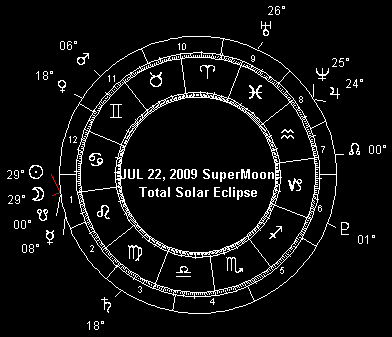 That said, there's no harm in making sensible preparations for the SuperMoons of 2009. What's the worst that can happen, if the worst doesn't happen? Where's the harm in having a few extra fresh batteries and candles, some extra bottled water and canned goods, maybe a full tank of gas and an evacuation bag packed just in case? (The US Department of Homeland Security has a detailed evacuation kit inventory that, to quote them, "could mean the difference between life and death".) And maybe you'll think twice about being in transit and more than usually vulnerable to the vagaries of weather hazards and delays. These may amount to only minor inconveniences. But they're the kind of sensible precautions that can make a big difference if the worst does come to pass. I can only call the dates. You have to make the decision, and take the action, to be prepared or not.
That said, there's no harm in making sensible preparations for the SuperMoons of 2009. What's the worst that can happen, if the worst doesn't happen? Where's the harm in having a few extra fresh batteries and candles, some extra bottled water and canned goods, maybe a full tank of gas and an evacuation bag packed just in case? (The US Department of Homeland Security has a detailed evacuation kit inventory that, to quote them, "could mean the difference between life and death".) And maybe you'll think twice about being in transit and more than usually vulnerable to the vagaries of weather hazards and delays. These may amount to only minor inconveniences. But they're the kind of sensible precautions that can make a big difference if the worst does come to pass. I can only call the dates. You have to make the decision, and take the action, to be prepared or not.
The first SuperMoon of 2009 falls on January 11 at 21° 02’ Cancer, and is the third full moon SuperMoon in a row. It’s also particularly potent, for a couple of reasons: it’s the second closest SuperMoon of the year (within a few hundred kilometers of the closest), and it occurs within a week of Earth’s closest annual approach (perihelion) to the Sun. Expect the full SuperMoon paraphernalia from the 8th through the 16th: an increase in coastal flooding due to higher than usual tides, a gaggle of strong storms with high winds and heavy precipitation (triggering inland flooding), and of course an up-tick in moderate to severe seismic activity (including magnitude 5+ earthquakes as well as volcanic eruptions). Most especially, given its coincidence with the Mercury retrograde station on the 11th (just a week after Mercury’s first intersolar cycle of the year has begun), this alignment looks like a harbinger of severe weather events, the kind that tie up transportation infrastructure. If you must travel during this period, it would be a good idea to be prepared for weather delays at the very least. The Ringed Planet’s retrograde turn on the last day of 2008 means that this January SuperMoon occurs as Saturn and Uranus are within just a couple degrees of their February 5 exact opposition alignment. It’s a combination that suggests a fresh rash of negative economic news, the sort of thing that drives equity markets and consumer confidence in a downward direction. That may be putting it mildly.
Being planetary in scale, there’s no place on our home planet that’s beyond the range of a SuperMoon, so it wouldn’t hurt to make ready wherever you are or plan to be during the January 8-16 SuperMoon risk window. That said, possible zones of special vulnerability may be indicated by astro-locality mapping the January 11 SuperMoon. Higher risk sectors align with longitudinal zones running from western Greenland down through eastern South America in the western hemisphere, and from eastern China down through Japan, Indonesia, Papua New Guinea and central Australia in the eastern hemisphere. A secondary longitudinal risk factor runs from eastern Canada down through central South America in the west, and from Beijing down through Manila and Western Australia in the east. Horizon arcs sweep southeasterly from the Bering Strait to the Hawaiian Islands, and southwesterly across Siberia into the Middle East and along the southern coast of east Africa.
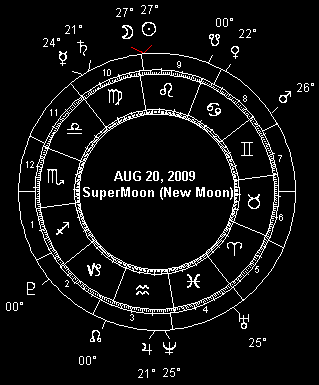 A series of three new moon SuperMoons begins on June 22, with the lunation at 1° 30' Cancer on the same day the Moon reaches maximum declination north of the celestial equator: a combination that signifies an extreme lunation, with enhanced tidal pull on the atmosphere, oceans and crust of Planet Earth. This one comes amidst a knot of celestial traffic as well, including Pluto’s opposition to the new moon itself, in addition to a pair of celestial alignments each within a degree of being exact: the first of this year’s three Jupiter-Neptune conjunctions, and a Venus-Mars conjunction that comes after these two planets have been within a couple degrees of each other for a couple months. Of course we should expect an upsurge in significant seismic and volcanic activity and strong storms with heavy precipitation and high winds, as well as unusual high tides during the June SuperMoon window, which extends from the 19th through the 25th. But given the simultaneous other alignments, I think there’s apt to be a bull run in the equity markets around this time – or a run on the banks. In other words, an amplification of fear or greed in the marketplace: I’m just not sure which. It looks more like a bull run than a bank run, more avaricious than fearful; but it really could go either direction. Be sure you get out of the way in any case. On the personal side, this is definitely a time of lust and excess . . . which can be outstanding or not, depending on whom you’re with.
A series of three new moon SuperMoons begins on June 22, with the lunation at 1° 30' Cancer on the same day the Moon reaches maximum declination north of the celestial equator: a combination that signifies an extreme lunation, with enhanced tidal pull on the atmosphere, oceans and crust of Planet Earth. This one comes amidst a knot of celestial traffic as well, including Pluto’s opposition to the new moon itself, in addition to a pair of celestial alignments each within a degree of being exact: the first of this year’s three Jupiter-Neptune conjunctions, and a Venus-Mars conjunction that comes after these two planets have been within a couple degrees of each other for a couple months. Of course we should expect an upsurge in significant seismic and volcanic activity and strong storms with heavy precipitation and high winds, as well as unusual high tides during the June SuperMoon window, which extends from the 19th through the 25th. But given the simultaneous other alignments, I think there’s apt to be a bull run in the equity markets around this time – or a run on the banks. In other words, an amplification of fear or greed in the marketplace: I’m just not sure which. It looks more like a bull run than a bank run, more avaricious than fearful; but it really could go either direction. Be sure you get out of the way in any case. On the personal side, this is definitely a time of lust and excess . . . which can be outstanding or not, depending on whom you’re with.
As always, the June 22 SuperMoon is planetary in scope. Be prepared, wherever you are at the time, for extreme weather and tides, plus notable seismic activity (including volcanic eruptions and magnitude 5+ earthquakes). Amplified risk areas suggested by astro-locality mapping this event include a longitudinal zone through the Rocky Mountain range in the New World as well as through Pakistan, Afghanistan, Kazakhstan and Russia in the Old. There’s also a horizon arc that sweeps northeasterly across South America from Peru to Venezuela and out into the Atlantic to graze the Canadian Maritimes and the southeast coast of Greenland; passing from there across northern Russia into Mongolia, China, Indochina, Indonesia and western Australia.
The next new moon SuperMoon is the total solar eclipse at 29° 27 Cancer, on July 22 – the first of two eclipse SuperMoons this year. Because it’s a solar eclipse, I give this SuperMoon an effective risk window extending from the 15th through the 29th. Strong storms with high winds and heavy precipitation would seem to be a specialty of this alignment: a surge in hurricane, tornado and typhoon activity will be a focus of this particular lunation, although it will have its tidal and seismic components as well.
Of course the geophysical risk associated with this alignment is global, as is always the case with a SuperMoon. But there are probably zones of special vulnerability indicated by the eclipse zone and astro-locality mapping for this event. The eclipse is visible over much of Asia and the South Pacific, and that makes it a likely indicator of powerful storms and heavy rain in the region. (Shanghai looks like the biggest city in the eclipse path, but many large Chinese as well as Indian population centers fall under the shadow of this eclipse.) astro-locality mapping picks up a longitudinal risk zone in the eastern hemisphere running from eastern Siberia down through Japan, Indonesia, Papua New Guinea and Australia, and through central Greenland and eastern Brazil in the west. Another risk zone centers on a horizon arc sweeping northeast from northern Baja California across the western US and through Winnipeg, arcing from there through northern and central Europe down through the Middle East.
The last of the 2009 trio of new moon SuperMoons occurs on August 20, at 27° 32’ Leo. It gives every appearance of indicating particularly strong tidal, storm and seismic events during the August 17-23 SuperMoon stress window. But given a simultaneous combination of other celestial events – Mercury conjunct Saturn opposing Uranus, Mars opposing Pluto, and the SuperMoon itself opposing Jupiter and Neptune – I think there’s a lot more than the geophysical to this one. It comes at a time of mounting interpersonal as well as geopolitical tensions, and increasing dislocations in the world’s economy in general and financial system in particular. Think safety, think security, minimize risk.
As for the geophysical drama – the storms, the tidal surges, the up-tick in moderate-to-severe earthquakes and volcanic activity – there’s no place on Earth beyond the reach of one or more of these manifestations. Wherever you are, it’s prudent to have your emergency kit and preparations ready just in case. If you’re going to be on the move during this SuperMoon, at least take the possibility of weather delays into consideration . . . maybe most especially if you’ll be in one of the astro-locality hot zones for this alignment. These include a longitudinal sector from Hawaii through Alaska in the New World, and from Eastern Europe down through east central Africa in the Old. There are also horizon arcs through eastern Canada and the northeastern US, sweeping across Venezuela and Brazil in South America to emerge on the other side of the world and crossing from Western Australia over Indonesia, the Philippines, east China and Japan onward to eastern Siberia.
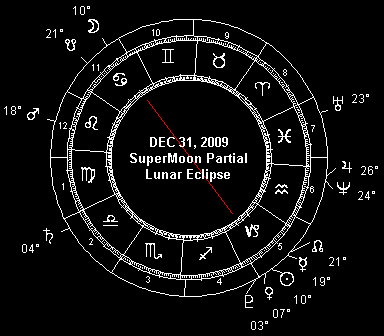 The last SuperMoon of the year, and the second SuperMoon eclipse, is the full moon partial lunar eclipse at 10° 15’ Cancer on December 31 – which just happens to be the first in a series of three full SuperMoons extending into 2010. It also looks like an especially potent harbinger of strong storms, high tidal surges, and notable earthquake and volcanic activity, given that it occurs just a day after the Moon reaches peak declination north of the celestial equator, and only a couple days before Earth’s closest approach to the Sun. The geophysical risk window for this one extends from December 28 into early January 2010.
The last SuperMoon of the year, and the second SuperMoon eclipse, is the full moon partial lunar eclipse at 10° 15’ Cancer on December 31 – which just happens to be the first in a series of three full SuperMoons extending into 2010. It also looks like an especially potent harbinger of strong storms, high tidal surges, and notable earthquake and volcanic activity, given that it occurs just a day after the Moon reaches peak declination north of the celestial equator, and only a couple days before Earth’s closest approach to the Sun. The geophysical risk window for this one extends from December 28 into early January 2010.
Of course the potential risks of any SuperMoon extend all over Planet Earth. So it’s good to have your emergency kit handy wherever you’ll be in the last days of 2009, and to figure on travel delays, power outages and the like due to bad weather – or worse. Astro-locality mapping may suggest a few especially high-risk zones, including a longitudinal swath through the Great Plains states in the US up into Canada in the New World, and from western India/eastern Pakistan northward in the Old; as well as along a horizon arc sweeping from southern Alaska across northern Canada and northeasterly across southeastern Australia.
Like SuperMoons, eclipses are important indicators of major geophysical stress. Tradition from ancient times associates eclipses with natural disasters. The Greek historian Thucydides (5th Century BCE) wrote about "an eclipse of the Sun at the time of a new moon, and in the early part of the same month an earthquake." In the 2nd Century CE his countryman Phlegon reported that "in the fourth year of the 202nd Olympiad, there was an eclipse of the Sun . . . and a great earthquake that broke out in Bithynia destroyed the greatest part of Nicaea."
The association of seismic upheaval and other natural calamities with eclipses isn't solely a preoccupation of ancient historians. It survives to this day, because powerful earthquakes, notable volcanic eruptions and great storms persist in their synchronicity with eclipses. Examples closer to our own time include the May 8, 1902 eruption of Mt. Pelee, which left 29,000 dead and destroyed the city of St. Pierre in the West Indies - within a day of a SuperMoon that also happened to be a partial solar eclipse.
 My own rule of thumb, based on decades of observation and investigation, is that solar eclipses have a geophysical shock window that extends a week either side of the exact date, while lunar eclipses are effective within a plus or minus three day window. If the seven day-either way window for solar eclipses seems extravagant, consider that it represents an orb (allowance or tolerance) of only seven degrees for the Sun; and that eclipses can happen when the Sun and Moon align within as much as 18 degrees either side of the lunar nodes. Given that it's less than half the effective orb between the lunar nodes and a new moon eclipse, seven degrees might not look so large after all.
My own rule of thumb, based on decades of observation and investigation, is that solar eclipses have a geophysical shock window that extends a week either side of the exact date, while lunar eclipses are effective within a plus or minus three day window. If the seven day-either way window for solar eclipses seems extravagant, consider that it represents an orb (allowance or tolerance) of only seven degrees for the Sun; and that eclipses can happen when the Sun and Moon align within as much as 18 degrees either side of the lunar nodes. Given that it's less than half the effective orb between the lunar nodes and a new moon eclipse, seven degrees might not look so large after all.
The eclipse roll for 2009 begins with the annular solar eclipse on January 26 at 6° 30' Aquarius, conjunct Jupiter. It's the 50th solar eclipse in Saros Series 131, which began with the partial solar eclipse of August 1, 1125. While the seismic potential associated with this alignment cannot be ignored during the January 19-February 2 geocosmic risk window, I’m expecting it to make its mark as a major storm signal worldwide. If there are areas of particular storm and seismic vulnerability, they’re likely to be found in the eclipse’s zone of visibility: mostly over open ocean from the South Atlantic into the South Pacific and across Indonesia. Additional risk zones are suggested by Astro-locality mapping, in the western hemisphere along a longitudinal zone running from Alberta and British Columbia down through Idaho, Nevada and California; and in the eastern hemisphere, along the Iranian border with Pakistan and Afghanistan northward through Turkmenistan, Uzbekistan, Kazakhstan and Russia.
The eclipse being conjunct Jupiter promises a lot of optimism, big ideas and big plans in late January. That it happens in the retrograde portion of Mercury’s first intersolar cycle of the year suggests that the devil is, as always, in the details. More immediately, the devil is in the fierce storms that snarl transportation (many wrecks and wrecked schedules) and incapacitate power and communication infrastructure.
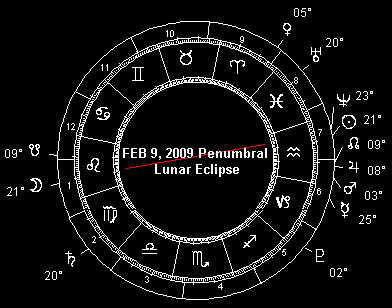 The penumbral lunar eclipse of February 9 at 21° 00’ Leo opposes Neptune, just days after Saturn and Uranus make the first of their opposition alignments in 2009. This one has an effective geophysical shock window that stretches from the 4th (a day in advance of the Moon’s north declination maximum on the 5th) all the way through the 12th. Panic in the markets, panic in the streets, people in need of rescue, just a whiff of revolution in the air . . . and speaking of the air, this is a storm signal par excellence, although its potential accompaniment by moderate to severe earthquake activity (magnitude 5+) or volcanic eruption should not be discounted. This full moon eclipse will be visible (though fairly faint) in Australia and east Asia, Alaska and Hawaii, and the western US and Canada: these are areas of special susceptibility to storms and seismic shock during the eclipse shock window. Additional areas are suggested by astro-locality mapping the event. They include longitudinal zones running from east-central Greenland through eastern Brazil in the western hemisphere, and from eastern Siberia down through Japan, eastern Indonesia/Papua New Guinea and east central Australia in the eastern hemisphere.
The penumbral lunar eclipse of February 9 at 21° 00’ Leo opposes Neptune, just days after Saturn and Uranus make the first of their opposition alignments in 2009. This one has an effective geophysical shock window that stretches from the 4th (a day in advance of the Moon’s north declination maximum on the 5th) all the way through the 12th. Panic in the markets, panic in the streets, people in need of rescue, just a whiff of revolution in the air . . . and speaking of the air, this is a storm signal par excellence, although its potential accompaniment by moderate to severe earthquake activity (magnitude 5+) or volcanic eruption should not be discounted. This full moon eclipse will be visible (though fairly faint) in Australia and east Asia, Alaska and Hawaii, and the western US and Canada: these are areas of special susceptibility to storms and seismic shock during the eclipse shock window. Additional areas are suggested by astro-locality mapping the event. They include longitudinal zones running from east-central Greenland through eastern Brazil in the western hemisphere, and from eastern Siberia down through Japan, eastern Indonesia/Papua New Guinea and east central Australia in the eastern hemisphere.
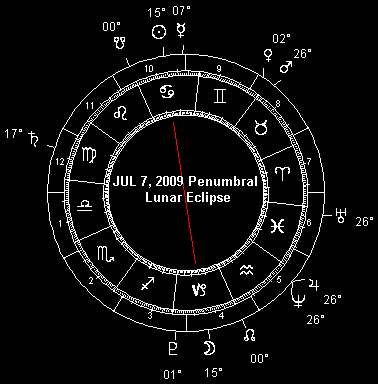 The July 7 penumbral lunar eclipse at 15° 24’ Capricorn is even fainter than its antecedent; invisible to the naked eye, in fact. But it has a notable celestial entourage, including a very tight Jupiter-Neptune conjunction and a rather wide Venus-Mars alignment. A rather more hopeful period than the February lunar eclipse, in terms of the political and economic environment, I should think: people want to believe the Pied Piper can rid the global village of its ills. On the geophysical front, there may be more to this one. It’s in effect from the 4th through the 13th (amplified by the Moon’s south declination extreme on the 5th, and extended by the northward lunar equatorial crossing on the 12th). As always, this is a global phenomenon, in terms of its potential for severe storms with high winds and heavy precipitation, plus moderate to severe seismicity (including magnitude 5+ earthquakes as well as volcanic eruptions. Far western Canada (near the Alaskan border) is one of the two longitudinal zones astro-locality mapping plots as a zone of special risk during this eclipse window. On the other side of the world, a longitudinal sector from Moscow down through the Middle East and east Africa is similarly suspicious looking. There’s also a horizon arc sweeping across western Australia and Indonesia through the Bering Strait, bending down to cross eastern Canada and the northeastern US (passing over Montreal and Boston, and close enough to count to New York City), turning south from there to pass through the eastern third of Brazil. (Sri Lanka, Indonesia, eastern India, Indochina and central China are crossed by additional risk lines for this eclipse.)
The July 7 penumbral lunar eclipse at 15° 24’ Capricorn is even fainter than its antecedent; invisible to the naked eye, in fact. But it has a notable celestial entourage, including a very tight Jupiter-Neptune conjunction and a rather wide Venus-Mars alignment. A rather more hopeful period than the February lunar eclipse, in terms of the political and economic environment, I should think: people want to believe the Pied Piper can rid the global village of its ills. On the geophysical front, there may be more to this one. It’s in effect from the 4th through the 13th (amplified by the Moon’s south declination extreme on the 5th, and extended by the northward lunar equatorial crossing on the 12th). As always, this is a global phenomenon, in terms of its potential for severe storms with high winds and heavy precipitation, plus moderate to severe seismicity (including magnitude 5+ earthquakes as well as volcanic eruptions. Far western Canada (near the Alaskan border) is one of the two longitudinal zones astro-locality mapping plots as a zone of special risk during this eclipse window. On the other side of the world, a longitudinal sector from Moscow down through the Middle East and east Africa is similarly suspicious looking. There’s also a horizon arc sweeping across western Australia and Indonesia through the Bering Strait, bending down to cross eastern Canada and the northeastern US (passing over Montreal and Boston, and close enough to count to New York City), turning south from there to pass through the eastern third of Brazil. (Sri Lanka, Indonesia, eastern India, Indochina and central China are crossed by additional risk lines for this eclipse.)
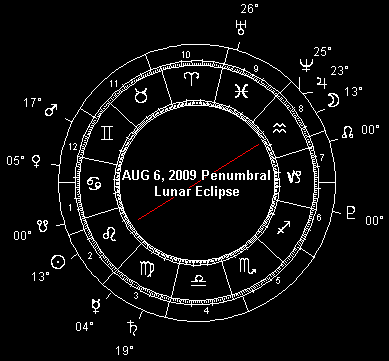 Following the July 22 total solar eclipse – already discussed in the SuperMoon section above – there’s another barely perceptible penumbral lunar eclipse on August 6, at 13° 43’ Aquarius. Although invisible to the naked eye, this one is accompanied by another notable planetary alignment; namely, once more, the Jupiter-Neptune conjunction, indicating a sense of hope and a willful denial of reality. There’s no denying the storm and seismic potential on a planetary scale during this particular eclipse window, which stretches from the 3rd through the 9th. Its worldwide potential aside, there are some rather ominous looking astro-locality indicators of special risk zones for this eclipse. They include a couple longitudinal sectors; one running from west Africa northward to just off the east coast of Iceland, and another running from far eastern Siberia down through New Zealand. There’s also a horizon arc running across Mexico and the western end of the Gulf of Mexico through the Mississippi River basin and across the Great Lakes into Canada, and sweeping across southern Greenland the North Atlantic to cross Scandinavia and Russia down into Afghanistan, Pakistan and India.
Following the July 22 total solar eclipse – already discussed in the SuperMoon section above – there’s another barely perceptible penumbral lunar eclipse on August 6, at 13° 43’ Aquarius. Although invisible to the naked eye, this one is accompanied by another notable planetary alignment; namely, once more, the Jupiter-Neptune conjunction, indicating a sense of hope and a willful denial of reality. There’s no denying the storm and seismic potential on a planetary scale during this particular eclipse window, which stretches from the 3rd through the 9th. Its worldwide potential aside, there are some rather ominous looking astro-locality indicators of special risk zones for this eclipse. They include a couple longitudinal sectors; one running from west Africa northward to just off the east coast of Iceland, and another running from far eastern Siberia down through New Zealand. There’s also a horizon arc running across Mexico and the western end of the Gulf of Mexico through the Mississippi River basin and across the Great Lakes into Canada, and sweeping across southern Greenland the North Atlantic to cross Scandinavia and Russia down into Afghanistan, Pakistan and India.
(For details on the last eclipse of the year, which also happens to be a SuperMoon, see the section on SuperMoon alignments.)
SuperMoons and eclipses are not the only celestial phenomena to turn up every year. Another familiar annual theme involves the cycles of Mercury. Being closest to the Sun, Mercury goes intersolar as seen from Earth more than any other planet; several times a year in fact, including the infamous Mercury retrogrades of astrological legend. While most astrologers pay a fair amount of attention to Mercury's retrograde, few realize that it's only a part of the more fundamental intersolar phase in the orbital interaction between Mercury and Earth, as they both orbit around the Sun.
 Mercury's intersolar phase begins when the little Sun-grazer reaches its maximum elongation east of the Sun - its evening star phase. This happens when Mercury has come 'round to the same side of the Sun as Planet Earth, and is relatively near us. The little planet is then pulling up to pass Earth on the inside track, as it were; catching up to us from behind and then passing between us and the Sun. Just as it catches up with us, Mercury passes directly between Earth and the Sun. This is Mercury's inferior conjunction with the Sun. After the inferior conjunction, Mercury continues pulling ahead of us until it reaches its greatest elongation west of the Sun (its morning star phase), at which point the little planet is headed toward the far side of our parent star. Between these two extremes, the greatest east and west elongations, comes the fabled Mercury retrograde period of astrological lore.
Mercury's intersolar phase begins when the little Sun-grazer reaches its maximum elongation east of the Sun - its evening star phase. This happens when Mercury has come 'round to the same side of the Sun as Planet Earth, and is relatively near us. The little planet is then pulling up to pass Earth on the inside track, as it were; catching up to us from behind and then passing between us and the Sun. Just as it catches up with us, Mercury passes directly between Earth and the Sun. This is Mercury's inferior conjunction with the Sun. After the inferior conjunction, Mercury continues pulling ahead of us until it reaches its greatest elongation west of the Sun (its morning star phase), at which point the little planet is headed toward the far side of our parent star. Between these two extremes, the greatest east and west elongations, comes the fabled Mercury retrograde period of astrological lore.
Retrograde means moving backwards. This is what Mercury appears to do in our skies when the little inner planet catches up on us and passes us on the inside, between Earth and the Sun. First Mercury reaches its greatest eastern elongation, then it appears to stand still in the sky (the retrograde station), and then it appears to move backwards through the heavens for a period of several weeks: that's Mercury retrograde for you. It ends when the little Sun-grazer's backwards motion comes to an apparent halt (the direct station); after which, Mercury moves forward again, until it reaches its maximum elongation west of the Sun. The reality of course is that Mercury never stops in its orbit, and never moves backward: this is only how the relative motions of Earth and Mercury around the Sun cause Mercury to move through our night sky.
Mercury retrograde is the cycle when everything goes wrong, to hear some astrologers tell it. The truth is not so simple-minded. All things Mercurial are crucial during the intersolar Mercury phase; infrastructure, commerce, information, communication and transport being prime examples. Absent careful investigation and planning, and conscientious follow-through, all such things are apt to go off track during these cycles. Mercury's intersolar phase is a time for focus, concentration, planning, follow-through and communication - all the qualities of the active and involved mind, in short. In case you haven't noticed, most people are not especially alert and focused most of the time. When this kind of sleepwalking runs into Mercury's intersolar cycle, with its focus on mental acuity, it doesn't take long for things to go awry. If you're sharp and focused and alert, you can avoid a certain amount of this mess. In fact, you can even prosper by concentrating on tasks that center on thought, planning and communication. But you'll still have to dodge all the chaos created by the people who are sleepwalking. So be ready.
Among the sort of things to be ready for during the above mentioned Mercury intersolar cycles: strikes and other disruptions affecting transportation and communication (e.g. postal, phone, mass transit, trucking, airline, shipping, dock and warehouse workers, teachers and all manner of media). Weather both terrestrial and solar (including geomagnetic storms) can play a part in the kind of breakdowns described here, but human effort (and sometimes malicious action) is a part of the mix as well. Power failures due to infrastructure breakdown and computer network disruptions caused by hacker attacks, software vulnerabilities and the like are also just a crossed wire or a keystroke away from a major mess at these times.
If I had to pick a day to have a backup generator all fueled up and ready to go, a contingency plan in place in case the scheduled or expected didn't come to pass, a day to be especially sharp and steady and focused - it would be during one of these Mercury cycles. Note these dates; be ready with a fallback plan just in case. It's not so much that disaster is destined to strike when Mercury is in its intersolar phase. Rather, it's that everything pertaining to Mercury becomes crucial; and unless it's treated as such, then it goes awry. More and more, we live in a "just in time" world - and if the slightest delay holds up just one single thing, then a whole process screeches to a halt. Unfortunately, few people keep their eye on the ball with any consistency and diligence. And that's the reason these Mercury cycles tend to turn into Murphy's Law festivals. Practically speaking, this means that having a "just in time" inventory of essentials is risky business at times like this. Don't say I didn't warn you!
The first intersolar Mercury phase of 2009 begins with the little planet's maximum eastward elongation on January 4, includes the January 11-February 1 retrograde and the January 20 inferior conjunction with the Sun, and ends with Mercury's greatest western elongation on February 13. Next comes the April 26 greatest eastern elongation, initiating a Mercury intersolar cycle which includes the May 7-31 retrograde and the May 18 inferior conjunction, and concludes with the June 13 western elongation maximum. Mercury’s August 24 greatest elongation east of the Sun marks the next intersolar cycle of the little planet, which continues through the September 7-29 retrograde and the September 20 inferior conjunction, ending with Mercury’s maximum western elongation on October 6. Finally this year comes the Mercury intersolar phase that starts with the maximum eastern elongation on December 18, includes the December 26-January 15, 2010 retrograde and the January 4 inferior conjunction, and wraps up with the western elongation extreme on January 27, 2010.
There are only two planets inside Earth’s orbit; namely Mercury and Venus, the so-called inferior (inner) planets. By definition, only the inferior planets are capable of having what I have termed an intersolar cycle; because only an inferior planet can pass between Earth and the Sun. While Mercury manages several intersolar cycles every year, the only other planet capable of such a phase does so just once every year and a half or so. This is one of those years, beginning with Venus as evening star (Venus Vesper) reaching maximum elongation east of the Sun on January 14, just a few days after the first SuperMoon of 2009. The cycle ends with Venus the morning star (Venus Lucifer, aka Venus Hesperus) attaining its greatest western elongation on June 5 at 29° 33’ Aries. In between comes the Venus retrograde cycle, beginning with the retrograde station on March 8 (as Mars aligns with Neptune) and concluding with the direct station on April 17 (two days before the first Venus-Mars conjunction of the year). And in the middle of it all is the keynote of the whole cycle, the inferior conjunction with the Sun on March 27, as Venus passes directly between Earth and Sun.
 Most people are well aware of Mercury's retrograde, but not much attention is given to the retrogrades of other planets. When an inner planet in its faster orbit starts catching up on the slower orbiting Earth, the inner planet's apparent motion in our night sky begins to slow. It moves slower and slower until it comes to an apparent standstill in the heavens. This is the retrograde station, the point at which the planet appears to stop and then begin moving backwards (clockwise, or westward) through the sky. This period of reverse motion continues for some weeks (roughly three weeks for Mercury, about seven weeks for Venus), until the planet once more slows its nightly progress through the sky and again comes to an apparent standstill - the direct station, in this case. Normal counterclockwise (eastward) motion then resumes, until the next intersolar cycle brings a new retrograde.
Most people are well aware of Mercury's retrograde, but not much attention is given to the retrogrades of other planets. When an inner planet in its faster orbit starts catching up on the slower orbiting Earth, the inner planet's apparent motion in our night sky begins to slow. It moves slower and slower until it comes to an apparent standstill in the heavens. This is the retrograde station, the point at which the planet appears to stop and then begin moving backwards (clockwise, or westward) through the sky. This period of reverse motion continues for some weeks (roughly three weeks for Mercury, about seven weeks for Venus), until the planet once more slows its nightly progress through the sky and again comes to an apparent standstill - the direct station, in this case. Normal counterclockwise (eastward) motion then resumes, until the next intersolar cycle brings a new retrograde.
Now that you've got the picture, one thing should be clear: during its intersolar cycle, an inferior planet is actually closer to Earth, making it brighter and more prominent in our sky. In the case of Venus, this tends to coincide with a period of relative ease and prosperity, all else being equal. All else is far from equal, this time around. This year’s Venus intersolar cycle starts out under the aegis of one of 2009’s signature alignments (Saturn and Uranus being within a few degrees of exact opposition), at a time when the Moon is aligned with Saturn in the sky – and at the other end of the heavens are Venus and Uranus, opposing the Moon and Saturn. Venus turns retrograde on March 8, a day when Saturn is at its closest point to Earth for the year and within only a few degrees from its exact opposition to Uranus. The retrograde ends with Venus conjunct Mars and Uranus, and the Venus intersolar cycle as a whole ends on June 5, just days after the first Jupiter-Neptune conjunction of the year - the other signature alignment of 2009.
All things considered, I see the January 14-June 5 Venus intersolar cycle of 2009 as arguably the most positive part of the year, as far as financial markets and economic development go. They don’t go very far, alas: I see hopeful signs and encouraging fits and starts, but not enough underlying strength and stability to get any lasting traction. The macro trends dominating the year as a whole remain deflationary until they turn dangerously inflationary, and that’s not a good place to be. But that’s where we are, and it’s better to know it than not.
Mars goes retrograde this year as well, reversing its apparent course in the sky on December 20, after a couple months of slowing down in the sky as Earth catches up from its niche inside the Martian orbit. The Red Planet's retrograde cycle ends on March 10, 2010, after its January 30 opposition to the Sun and closest approach to Earth. Mars is finally up to speed again by early June.
 Mars cycles of this sort happen only once every couple years or so. They're not unlike the intersolar cycles of Mercury and Venus, in that they emphasize the nature of the planet in question during that portion of its orbit where it passes closest to Earth. But unlike Mercury and Venus, Mars orbits outside our home planet's path. Technicalities aside, the high Mars cycle runs from roughly the waxing to the waning square (90° angle) of the Sun to Mars; i.e., from the time the Sun moves up to about 90 degrees ahead of Mars to when it moves to about 90 degrees behind Mars. So the high Mars cycle that begins in October 2009 will conclude in June 2010. While it continues, we remain in a period of elevated tension and conflict, the kind of atmosphere that cultivates inflamed passions, hot tempers and rash, even violent action - of the criminal and military type, from terrorist atrocities to large scale military conflict. (The last such Mars cycle was accompanied by Israel’s bombing of a Syrian nuclear facility, the assassination of Benazir Bhutto, etc.) Apart from the direct impact of the fires, clashes, crashes and explosions that are par for the course under this sort of Mars close pass, some such incidents can raise the possibility of a disruption in the oil and natural gas supply chain - which in turn can shock the financial markets and put investors and institutions in a mad dash for the exits.
Mars cycles of this sort happen only once every couple years or so. They're not unlike the intersolar cycles of Mercury and Venus, in that they emphasize the nature of the planet in question during that portion of its orbit where it passes closest to Earth. But unlike Mercury and Venus, Mars orbits outside our home planet's path. Technicalities aside, the high Mars cycle runs from roughly the waxing to the waning square (90° angle) of the Sun to Mars; i.e., from the time the Sun moves up to about 90 degrees ahead of Mars to when it moves to about 90 degrees behind Mars. So the high Mars cycle that begins in October 2009 will conclude in June 2010. While it continues, we remain in a period of elevated tension and conflict, the kind of atmosphere that cultivates inflamed passions, hot tempers and rash, even violent action - of the criminal and military type, from terrorist atrocities to large scale military conflict. (The last such Mars cycle was accompanied by Israel’s bombing of a Syrian nuclear facility, the assassination of Benazir Bhutto, etc.) Apart from the direct impact of the fires, clashes, crashes and explosions that are par for the course under this sort of Mars close pass, some such incidents can raise the possibility of a disruption in the oil and natural gas supply chain - which in turn can shock the financial markets and put investors and institutions in a mad dash for the exits.
I should point out that you might want to begin investigating nuclear electromagnetic pulse (EMP), if you haven’t already started getting up to speed. EMP is the reason for current generation anti-missile development. A single nuclear weapon detonated at high altitude over the geographic center of North America or Europe would kill no one – except the entire technological infrastructure that keeps everyone alive. Late 2009 into early 2010 is about as soon as I can see any real potential for the use of such a weapon. Longtime nuclear powers know all about it, and have long had the capability to do this. But it’s not in their interest to deploy such a weapon. Terrorist organizations, on the other hand, have everything to gain and nothing to lose by unleashing a well-placed EMP device. There are steps anyone can take to safeguard against EMP effects, and it wouldn’t hurt to start getting acquainted with them.
Criminality, terrorism, military conflict: these things are always with us, even if they are especially prominent during Mars cycles like the one that continues into June 2010. But there's no need to panic. This isn't the end of the world. These bloody Mars cycles come up every couple of years, so we've survived plenty of them to date. Just be aware of the heightened potential for violence, irritability, haste and conflict, and act accordingly. In particular, the period around the Mars retrograde and direct stations (December 20, 2009 and March 10, 2010) are among the peak points in this kind of potential, as well as the day of the Sun-Mars opposition (January 30, 2010).
While most of the really heightened Mars action in the sky takes place in 2010, the whole last three months of the year represent a high stakes time of tension that could break out into open hostility at just about any time. And the dates associated with the Mars slowdown and retrograde are far from the only amplified Mars presence in all of 2009. There’s also the Mars conjunction with Jupiter on February 17, and with Uranus on April 15. In between them comes the Mars-Saturn opposition on April 5.
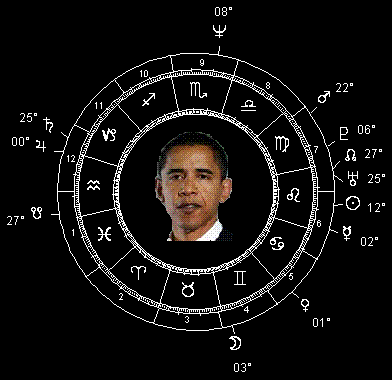 However there are plenty of other critical Mars points this year, coming around January 29, 2009 (Mars at the degree of the January 15, 2010 solar eclipse), February 13 (Mars crossing the degree of the January 26, 2009 solar eclipse), February 16 (Mars opposing the degree of the August 1, 2008 solar eclipse), March 7, 2009 (Mars at the degree of the August 16, 2008 lunar eclipse, September 11, 2009 (Mars at the degree of the December 31, 2009 lunar eclipse), and October 15, 2009 (Mars transiting the degree of the July 22, 2009 solar eclipse). These are the dates - all give or take a week or so - when you want to keep your wits about you, your focus on your immediate situation. No daydreaming - this is a time to stay aware and safety-conscious! This is personal for all of us, but most especially for people who have key points in their natal horoscope in the 5-25° Virgo range – like President Obama, based on his chart as calculated from his published birth certificate data.
However there are plenty of other critical Mars points this year, coming around January 29, 2009 (Mars at the degree of the January 15, 2010 solar eclipse), February 13 (Mars crossing the degree of the January 26, 2009 solar eclipse), February 16 (Mars opposing the degree of the August 1, 2008 solar eclipse), March 7, 2009 (Mars at the degree of the August 16, 2008 lunar eclipse, September 11, 2009 (Mars at the degree of the December 31, 2009 lunar eclipse), and October 15, 2009 (Mars transiting the degree of the July 22, 2009 solar eclipse). These are the dates - all give or take a week or so - when you want to keep your wits about you, your focus on your immediate situation. No daydreaming - this is a time to stay aware and safety-conscious! This is personal for all of us, but most especially for people who have key points in their natal horoscope in the 5-25° Virgo range – like President Obama, based on his chart as calculated from his published birth certificate data.
Incidentally, Mars aligns with Jupiter at 10° Aquarius on February 19, 2009 – the day all full-power broadcast TV stations in the US are scheduled to stop broadcasting on analog airwaves and begin broadcasting in digital only. (Saturn and Uranus at the time will be within less than two degrees of their exact February 5 opposition.)
In summary, now that all the major themes described in last year’s forecast have come to pass, about the best I can offer at this point is to remind you that the global economic leveling-off I predicted ("if not an outright downturn,") is now in full swing, as the world's nations and central banks attempt to come to grips with their counterfeit currency. There was a time in the Old South of US history when Confederate paper money actually bought things, and there followed an epoch when it was good only for kindling fires. Likewise there was a time during the 1920s German Weimar Republic when people burned marks for to stay warm in the winter because the paper lasted longer than the wood it would buy, thanks to hyperinflation. As I wrote last year, we're on the cusp between world historic epochs now, with respect to all the world's major currencies and the entire global financial system. A new world order is being built in this time of Trigonalis (1980-2020), and a new monetary system is part of its foundation: think international rather than national currencies, for starters. Per my forecasts for the past several years, we've seen the collapse of the old global financial structure gathering momentum under the aegis of the Great T-Square sequence. The debacle continues to grow this year, under the aegis of the Saturn-Uranus opposition that began in late 2008 and continues on-and-off until 2010. And with the 2009 triple Jupiter-Neptune conjunction at play, hyperinflation and major national bankruptcies are a real risk. I don't think it's all settled and done in the next year or two, because I see other major celestial signposts on the way to 2020. It's clear that the big shake-out has more than just begun. It’s years past that initial stage now.
ACKNOWLEDGMENTS: All astrological charts as well as eclipse and astro-locality maps were calculated and produced using Matrix Software's WinStar Plus 2.05 and Esoteric Technologies’ Solar Fire Gold Version 7.0.8. Additional astronomical diagrams and calculations were produced with John Walker's HomePlanet 3.1 and Maris Technologies' RedShift 5 software. Fred Espenak's NASA Eclipse Home Page is an indispensable online reference. Thanks to Alan Brown for many hours of discussion on historical details mentioned in this forecast.